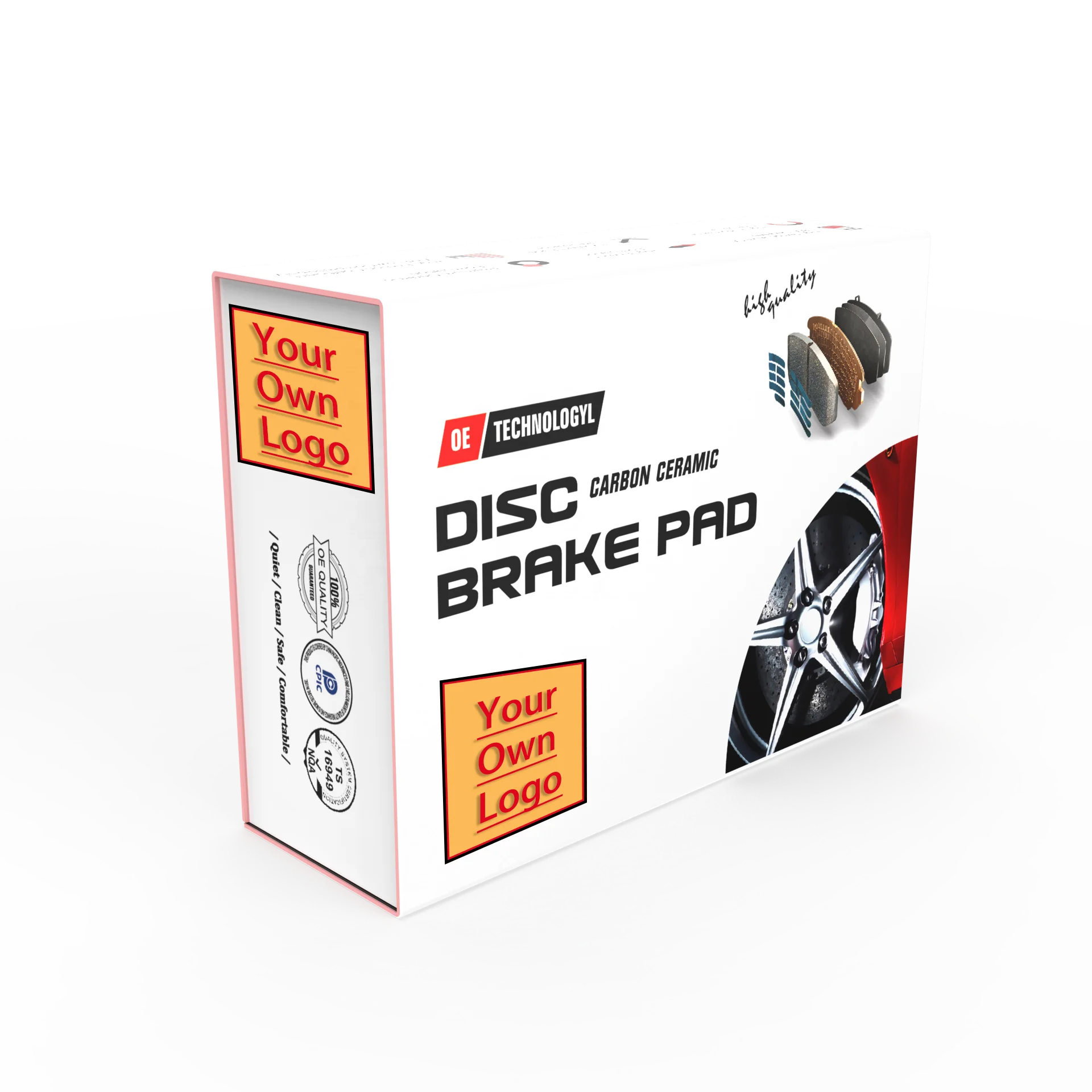Vehicle safety remains paramount for every driver, and among all safety components, automotive brake pads stand as the first line of defense against potential accidents. These critical components convert kinetic energy into heat through friction, enabling vehicles to stop effectively and safely. Understanding the importance of quality automotive brake pads can mean the difference between a safe journey and a dangerous situation on the road. Modern vehicles rely heavily on advanced braking systems, making the selection of appropriate brake pads crucial for optimal performance and safety.

The automotive industry has witnessed significant advancements in brake pad technology over recent decades. Manufacturers now offer various formulations designed to meet specific driving conditions, vehicle types, and performance requirements. From ceramic compounds that provide quiet operation to semi-metallic formulations that excel in heavy-duty applications, the diversity of available options ensures that every driver can find suitable brake pads for their needs. Professional mechanics and automotive enthusiasts alike recognize that investing in premium brake pads directly correlates with enhanced vehicle safety and reduced maintenance costs over time.
Understanding Brake Pad Materials and Technologies
Ceramic Brake Pad Composition
Ceramic automotive brake pads represent the pinnacle of modern brake pad technology, incorporating advanced ceramic fibers and copper strands to create a superior braking surface. These pads generate minimal dust compared to traditional formulations, keeping wheels cleaner and reducing environmental impact. The ceramic composition provides consistent performance across various temperature ranges, making them ideal for daily driving conditions. Additionally, ceramic pads operate quietly, eliminating the squealing often associated with other brake pad materials.
The manufacturing process of ceramic brake pads involves precise temperature control and specialized bonding agents that ensure durability and longevity. These pads typically last longer than organic or semi-metallic alternatives, providing excellent value despite higher initial costs. Ceramic formulations also demonstrate superior heat dissipation properties, preventing brake fade during extended or aggressive braking scenarios. This thermal stability makes ceramic automotive brake pads particularly suitable for luxury vehicles and performance applications where consistent stopping power remains essential.
Semi-Metallic Brake Pad Performance
Semi-metallic brake pads incorporate steel wool, iron powder, and copper fragments within their friction material, creating robust braking performance suitable for heavy-duty applications. These pads excel in high-temperature environments, making them popular choices for commercial vehicles, trucks, and performance cars that experience frequent or intense braking conditions. The metallic content provides excellent heat conduction, helping to dissipate thermal energy away from braking surfaces and maintaining consistent stopping power.
While semi-metallic automotive brake pads may generate more dust and noise compared to ceramic alternatives, they offer superior durability and cost-effectiveness for many applications. Their aggressive friction characteristics provide strong initial bite and maintained performance under extreme conditions. Professional drivers and fleet operators often prefer semi-metallic formulations for their reliability and predictable performance characteristics across various weather conditions and driving scenarios.
Performance Characteristics of Premium Brake Pads
Stopping Distance Optimization
Premium automotive brake pads significantly reduce stopping distances through advanced friction formulations and improved heat management systems. Engineering teams continuously refine pad compounds to achieve optimal coefficient of friction while maintaining stability across temperature ranges. The relationship between pad material and rotor surface creates the foundation for effective energy transfer during braking events. Quality brake pads maintain consistent performance whether during emergency stops or gradual deceleration scenarios.
Testing protocols for high-performance brake pads involve rigorous evaluation under various conditions including wet weather, high-speed scenarios, and repetitive braking cycles. Manufacturers employ sophisticated dynamometer testing to simulate real-world conditions and validate performance claims. The resulting data helps engineers optimize pad formulations for specific vehicle applications and driving patterns. Advanced automotive brake pads incorporate feedback from professional racing teams and everyday drivers to ensure comprehensive performance across all use cases.
Thermal Management and Fade Resistance
Effective thermal management prevents brake fade, a dangerous condition where excessive heat reduces braking effectiveness when drivers need it most. Premium brake pads incorporate heat-resistant binders and friction materials that maintain their properties even under extreme thermal stress. The molecular structure of advanced brake pad compounds resists degradation at elevated temperatures, ensuring consistent performance during demanding driving conditions such as mountain descents or track driving.
Modern automotive brake pads feature chamfered edges and specialized backing plate designs that promote air circulation and heat dissipation. These engineering improvements work in conjunction with ventilated rotors to create comprehensive thermal management systems. Proper heat management extends brake pad life while maintaining safety margins during critical braking events. The integration of thermal barriers and heat-resistant adhesives further enhances the ability of premium brake pads to perform reliably under stress.
Installation and Maintenance Best Practices
Professional Installation Procedures
Proper installation of automotive brake pads requires specific tools, knowledge, and attention to detail that ensures optimal performance and safety. Professional technicians follow manufacturer specifications for torque values, break-in procedures, and component compatibility checks. The installation process involves careful cleaning of caliper assemblies, inspection of related components, and proper lubrication of contact points. Incorrect installation can compromise braking performance and potentially create dangerous driving conditions.
During installation, technicians verify rotor condition, check brake fluid levels, and ensure proper alignment of all components. New brake pads require a specific bedding process that allows the friction material to properly mate with rotor surfaces. This break-in period involves gradual heating and cooling cycles that optimize the contact interface between pads and rotors. Professional installation also includes comprehensive testing to verify proper operation before returning vehicles to service.
Maintenance Schedules and Inspection Points
Regular inspection of automotive brake pads prevents unexpected failures and maintains optimal braking performance throughout their service life. Visual inspection should occur during routine maintenance intervals, checking for even wear patterns, adequate thickness, and absence of contamination. Unusual wear patterns often indicate underlying issues such as caliper problems, rotor warping, or suspension component wear that requires immediate attention.
Maintenance schedules vary based on driving conditions, vehicle type, and brake pad formulation, but most manufacturers recommend inspection every 12,000 to 15,000 miles. Drivers who frequently encounter stop-and-go traffic, mountainous terrain, or towing conditions may require more frequent inspections. Professional technicians use specialized tools to measure pad thickness accurately and assess overall brake system health. Proactive maintenance ensures that automotive brake pads perform optimally and safely throughout their intended service life.
Selecting Brake Pads for Different Vehicle Applications
Passenger Car Requirements
Passenger vehicles require automotive brake pads that balance performance, comfort, and longevity for daily driving conditions. Most family cars benefit from ceramic or organic formulations that provide quiet operation and minimal dust generation while maintaining adequate stopping power for typical driving scenarios. The selection process considers factors such as vehicle weight, typical driving patterns, and owner preferences regarding noise and maintenance requirements.
Urban driving conditions place different demands on brake pads compared to highway cruising or rural driving patterns. City drivers experience frequent stop-and-go situations that generate more heat and require pads with good thermal stability. Conversely, highway drivers may prioritize longevity and quiet operation over maximum stopping power. Understanding these usage patterns helps drivers select appropriate brake pad formulations that match their specific needs and driving environments.
Commercial and Heavy-Duty Applications
Commercial vehicles and heavy-duty trucks require robust automotive brake pads capable of handling increased thermal loads and extended service intervals. Semi-metallic formulations typically perform best in these applications due to their superior heat conduction and durability characteristics. Fleet operators often specify brake pads based on total cost of ownership calculations that include initial purchase price, service life, and maintenance requirements.
Heavy-duty brake pads must withstand the extreme conditions associated with loaded vehicles, frequent stops, and extended operation periods. The friction material must maintain its properties under continuous thermal cycling while providing consistent pedal feel and stopping power. Quality control becomes particularly important for commercial applications where brake failure could result in significant safety hazards and economic losses. Professional fleet maintenance programs include regular brake system inspections and predictive maintenance protocols to ensure optimal safety and performance.
Economic Considerations and Value Analysis
Initial Cost Versus Long-Term Value
The relationship between initial brake pad cost and long-term value involves multiple factors beyond simple purchase price comparisons. Premium automotive brake pads typically command higher prices but often provide extended service life, reduced maintenance frequency, and improved overall performance. Economic analysis should consider factors such as replacement intervals, associated labor costs, and potential impact on other brake system components.
Budget-oriented brake pads may appear attractive initially but can result in higher total ownership costs due to shorter service life and increased replacement frequency. Additionally, inferior brake pads may cause accelerated rotor wear, leading to more expensive repairs and safety concerns. Comprehensive cost analysis includes consideration of warranty coverage, brand reputation, and availability of technical support when problems arise.
Performance Benefits and Safety Returns
Investment in quality automotive brake pads provides measurable returns through improved safety margins and enhanced driving confidence. Superior braking performance can prevent accidents and reduce insurance claims, providing financial benefits that extend beyond simple component costs. The peace of mind associated with reliable brake performance represents significant value for safety-conscious drivers and fleet operators.
Performance benefits include shorter stopping distances, better pedal feel, and maintained effectiveness under various conditions. These characteristics directly translate to improved vehicle control and accident avoidance capabilities. Professional drivers and safety experts recognize that brake system performance represents one of the most critical factors in overall vehicle safety, making quality brake pads an essential investment rather than an optional upgrade.
FAQ
How often should automotive brake pads be replaced
Brake pad replacement intervals depend on driving conditions, pad material, and vehicle type, but most automotive brake pads require replacement between 25,000 to 70,000 miles. Aggressive driving, frequent city driving, and mountainous terrain accelerate wear rates, while highway driving typically extends pad life. Regular inspections by qualified technicians help determine optimal replacement timing based on actual wear patterns rather than mileage alone.
What are the signs that brake pads need replacement
Common indicators include squealing or grinding noises, increased stopping distances, vibration during braking, and visible wear through wheel spokes. Many modern vehicles include brake pad wear sensors that illuminate dashboard warning lights when replacement becomes necessary. Drivers should never ignore these warning signs, as continued operation with worn automotive brake pads can damage rotors and compromise safety.
Can different brake pad materials be mixed on the same vehicle
Mixing different brake pad materials on the same axle is not recommended as it can create uneven braking forces and unpredictable vehicle behavior. However, using different materials front and rear is acceptable provided both sides of each axle use identical pads. Professional installation ensures proper material selection and maintains balanced braking performance across all wheels.
Do premium brake pads require special maintenance procedures
Premium automotive brake pads typically require the same basic maintenance as standard pads, including regular inspections, proper break-in procedures, and adherence to manufacturer specifications. However, some high-performance formulations may have specific bedding requirements or operating temperature ranges that require specialized knowledge. Following manufacturer recommendations ensures optimal performance and longevity regardless of pad material or price point.

